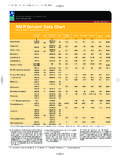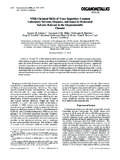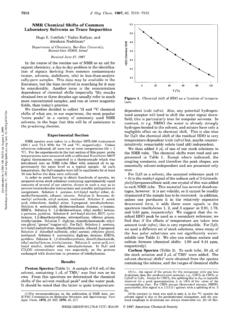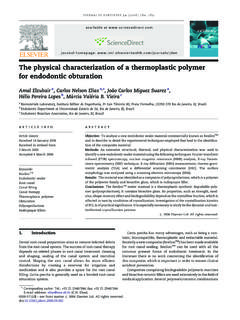Transcription of Accurate determination of ethanol in water by …
1 ORIGINAL ARTICLE. J. Chem. Metrol. 11:1 (2017) 9-15. Accurate determination of ethanol in water by qNMR: Validation and uncertainty assessment lker n* and Ahmet C Goren TUBITAK, UME, :54 41470 Gebze-Kocaeli, T rkiye (Received February 27, 2017; Revised March 23, 2017; Accepted March 25, 2017). Abstract: A rapid and simple method, having high reproducibility and low uncertainty for determination of low concentration of ethanol in water has been developed by using qNMR. Method validation was performed applying CRM and calibration solutions. The correlation coefficient for the analyte in the calibration interval was 1. At a concentration range of mg /g to 5 mg/g, the recovery was determined to be The relative uncertainties for ethanol solutions of mg/g and mg/g in water were found to be mg/g and mg/g, respectively.
2 Keywords: qNMR; ethanol ; traceability; method validation; uncertainty. 2017 ACG Publications. All rights reserved. 1. Introduction qNMR applications is now widely available in various fields, such as drug industry [1], manufacturing of reference materials [2], food analyses [3, 4] and metabolite determination in human body fluids [5-11]. Moreover, applications of qNMR involve determination of purity of a compound and amount and concentration of a sample inside a matrix. NMR is the sole method, which can determine, with one analysis, a small molecule having a single proton or an oligosaccharide possessing multiple protons. In addition to its easy and quick sample preparation procedure, recovering the sample after the analysis is possible especially in case of using external standard method, which is not possible with chromatographic techniques.
3 While the reference material is used as independent of the sample in qNMR, it must have a structural similarity to the sample in chromatographic analyses Also, the chromatographic techniques require calibration curve, but it is up to the operator in qNMR. Due to its practical and reliable results, it looks, qNMR will attract even more interest in near future with upcoming cost reductions. Following quantitative determinations of active substances in drug and food supplements by qNMR [12], a rapid measure of alcohol concentration in food samples, with high accuracy and lower uncertainty is possible. qNMR can be used as an alternative and practical method for determination the amount of ethanol instead of GC-MS in food samples [13]. This method is particularly applicable for liquid samples such as wine [14] and alcohols in frozen fruit extracts [15].
4 In European pharmacopeia, the limits for the presence of organic solvents in drug samples have already been established. ethanol has a concentration limit of 5000 ppm per day as it displays a lower toxicity [16]. The aim of this study is to determine the amount of ethanol in water samples at high and low concentration levels. The developed method will be fully validated and measurement uncertainty will be evaluated. *. Corresponding author: E-Mail: Tel.:(+90) 262 679 50 00 - 6109. The article was published by Academy of Chemistry of Globe Publications Published 03/31/2017. EISSN:1307-6183. qNMR for ethanol measurements in water 10. 2. Experimental Chemicals Sample for applications; ethanol - water Solution ( and ). Sample for trueness studies; Standard Reference Material 2894 NIST. Internal standard for ethanol concentration; 3- (Trimethylsilyl)propionic-2,2,3,3-d4 acid sodium salt (TSP-d4) Sigma Aldrich.
5 NMR Solvent;. Deuterium oxide % Merck. Internal standard for TSP-d4 purity; Benzoic acid Standard Reference Material NIST 350b. Certified reference material for traceability; Chloramphenicol Primary Calibrant UME CRM 1301 (certified value ). qNMR Conditions All NMR experiments were performed at K on a Varian VNMRS 600 spectrometer (Varian, San Francisco, CA, USA) operating at MHz for proton ( 1H) resonance frequency equipped with a 5 mm One NMR probe using 5 mm sample tubes (5 mm diameter, 178 mm length, Duran Group, Mainz, Germany). The VnmrJ (Agilent Technologies, Santa Clara, CA, USA) and MestReNova (Mestrelab Research , Santiago de Compostela, Spain) softwares were used for data acquisition and data processing, respectively. More detailed phase and baseline correction can be done with MestReNova software.
6 For this reason, MestReNova software was used for data processing. 1. H NMR experiments were recorded with 32 scans without sample spinning. The measurements were conducted with the following parameters optimized for 1H NMR: pulse angles of 90 , 64 k data points, acquisition time of 4 s and auto gain function. T1 was approximately s for ethanol -CH3 resonance, and s for TSP-d4 -CH3 resonance. 15xT1 was used to ensure a complete relaxation and reducing the influence of relaxation delay. Therefore the relaxation delay between two scans was set to 98 s. Spectral width of Hz and transmitter offset at ppm were applied. Fourier transformation was performed after zero filling the data to 64 k time domain points. Prior to Fourier transformation, an exponential line-broadening function of Hz was applied to FID (Free Induction Decay) in all NMR experiments.
7 During the data processing, phase and baseline were corrected manually and the signals were also integrated manually for the same region. Chemical shift was referenced to the TSP-d4 signal at ppm in D2O. Each sample was measured once due to the long analysis period, and the concentrations were calculated with the mean of the parallel detection results. Sample preparation The weighing processes were performed on a micro balance (XP56, Mettler-Toledo GmbH, Switzerland) with a readability of mg, certified by UME (T B TAK National Metrology Institute) and checked with the class E2 weights. The balance is positioned on a 500 kg stone table, with a U-electrode in place to remove potential static charge. Screw cap clear glass vials with the capacity of 4 ml were used for sample preparation. Firstly, an empty vial was weighed and then TSP- d4 was added as an internal reference (3-8 mg) into the vial.
8 The weighing was repeated 3 times for the empty vial and internal standard. Finally, water sample which contains ethanol was weighed ( mL). quickly in the same vial. mL D2O was added into the vial and screw cap was tightly closed. The solutions were mixed via vortex until a clear solution was obtained. Then, mL of solution was transferred into a NMR tube. 3. Results and discussion Theory Quantitative determination of ethanol concentration by qNMR was conducted by dissolving the sample with known quantity together with the internal standard in completely deuterated water . 11 n and Goren, J. 11:1 (2017) 9-15. The quantitative value was calculated using integral values of ethanol and the internal standard signals in the spectrum. In order to determine the correct integral values, phase and baseline corrections of the spectrum were made manually.
9 The calculation equation of qNMR for the analyte purity is as follows: (1). IStd, NStd, MStd, mStd and PStd are the peak area, number of proton, molecular weight, weighed mass and purity of the internal standard, respectively. The terms IEtOH, NEtOH, MEtOH, and CEtOH indicate the peak area, number of proton, molecular weight and concentration of the analyte ( ethanol ), mSample weighed mass for ethanol in water sample respectively. Method Validation Trueness, linearity, limit of detection (LOD), limit of quantification (LOQ), specificity and selectivitiy parameters were evaluated to validate the method. Additionally, traceability was established to obtain comparable results and measurement uncertainty was calculated. Trueness In order to assess trueness, two different ways were followed, in the first method the NIST.
10 2894 standard reference material, in which ethanol concentration was reported as mg/g . , was used. The results of the analysis conducted with 5 different samples are given in Table 1. When the obtained results were evaluated, it was determined that the ethanol concentration found by qNMR analysis and the certificate value of ethanol solution in water were very close to each other in terms of both concentration and uncertainty. Table 1. qNMR results of NIST 2894 SRM. NIST 2894 qNMR Results (mg/g). Sample 1 Sample 2 Sample 3 Sample 4 Sample 5 Mean Standard Deviation In the second validation method, qNMR analyzes were performed by preparing ethanol water solution in 6 different concentrations between mg/g and 5 mg/g. Recovery studies were conducted through dilution of the standard stock solution to different concentrations.






![Pharmacopeial Forum Vol. 35(5) [Sept.–Oct. 2009] …](/cache/preview/4/f/6/4/6/b/d/9/thumb-4f646bd9c98fa61ae166a740ef65637c.jpg)